The Wainwright Signed Prints
Guest article by Graham Wilkinson
Many people know about the Wainwright signed prints and may have even collected a few depicting their favourite locations. One question that occasionally arises concerns how many different prints were actually published. This subject has interested me for many years, and here I will share what I have learned. Let me emphasise at the outset that this is an ongoing pursuit, and if you can add to the story, I hope you will get in touch.
I bought my first “Wainwright Print” back in 2008 from an outdoor shop in Whalley. Over the years since then, I have added considerably to my collection. However, each new acquisition still provides the same excitement as I admire the beauty of AW’s penmanship and then reflect on how this item has passed briefly through the great man’s hands for the signature to be added. As my collection grew, I, too, wanted to know how many prints were published. Sadly, the official records no longer exist, so I spent several years compiling my own list after studying auction sales (including eBay), corresponding with other collectors who responded to an earlier appeal for help, and having some enjoyable conversations with Andrew Nichol, former book publishing manager at The Westmorland Gazette.
Andrew came up with the idea for the prints back in 1984. Wainwright fans had been keen to acquire his original drawings, pushing up prices beyond the reach of many. The signed prints were considered the next best thing, especially as each would be hand-signed by its celebrated creator. AW’s support was encouraged by a 25p payment provided on signing, not later when sold. The signed prints were available from 31 March 1985, ready for Easter.
Most of the actual illustrations are eight by six inches, the same size as in the sketchbooks for which they were drawn. Almost all are predictably in landscape format. With the surrounding white border, the prints measure ten by eight inches.
Four different sets of prints were produced: firstly came the Lakeland series, then the Dales, followed by Kendal in the nineteenth century and finally Ribble. There was a gap of several months between the launch of each collection. AW thought his Kendal in the nineteenth century drawings were his best, but these do not come up for sale often, nor do the Ribble series. Andrew would take the prints to AW’s Kendal home in batches of 500 for him to sign over a few days. Each signature was beautifully crafted in his customary green ink. He would regularly sign two batches each week. The prints are “open edition” as opposed to “limited edition” – they were never numbered, so it is uncertain how many were produced.
I know of 73 signed prints that were published. The titles are shown below in the form they appear on the prints, along with the drawing number from the sketchbooks from which they came. These are what I understand as the Wainwright prints: they all fit a standard format, were sold by different retailers in Cumbria and beyond, and were marketed directly to the public by the Gazette through adverts in local newspapers nationwide.
Lakeland Collection
- BOWFELL, from Lingmoor Fell (1) A Lakeland Sketchbook
- SCAFELL PIKE, from Throstle Garth (2) A Lakeland Sketchbook
- THIRLMERE (3) A Lakeland Sketchbook
- LANGDALE PIKES, from Lingmoor Fell (24) A Lakeland Sketchbook
- THE BUTTERMERE VALLEY (35) A Lakeland Sketchbook
- FRIAR’S CRAG, DERWENTWATER (38) A Lakeland Sketchbook
- THE NORTH-WESTERN FELLS (39) A Lakeland Sketchbook
- THE CONISTON FELLS (49) A Lakeland Sketchbook
- ULLSWATER, from St. Sunday Crag (78) A Lakeland Sketchbook
- BORROWDALE (143) A Second Lakeland Sketchbook
- GREAT END, from Styhead Tarn (174) A Third Lakeland Sketchbook
- DERWENTWATER, from Castle Head (238) A Third Lakeland Sketchbook
- WASDALE, from Great Gable (240) A Third Lakeland Sketchbook
- PATTERDALE (241) A Fourth Lakeland Sketchbook
- LANGSTRATH (243) A Fourth Lakeland Sketchbook
- SKELWITH FORCE (303) A Fourth Lakeland Sketchbook
- BLENCATHRA, from Castlerigg (327) A Fifth Lakeland Sketchbook
- WASTWATER, from Greathall Gill (330) A Fifth Lakeland Sketchbook
- VIEW FROM ORREST HEAD (348) A Fifth Lakeland Sketchbook
- ASHNESS BRIDGE (386) A Fifth Lakeland Sketchbook


Dales Collection
- HIGH FORCE (2) A Dales Sketchbook
- MAIN STREET, DENT (6) A Dales Sketchbook
- INGLEBOROUGH (10) A Dales Sketchbook
- MUKER (24) A Dales Sketchbook
- RICHMOND CASTLE (29) A Dales Sketchbook
- GAYLE (33) A Dales Sketchbook
- AYSGARTH FORCE: the lower falls (37) A Dales Sketchbook
- RIPON CATHEDRAL (43) A Dales Sketchbook
- FOUNTAINS ABBEY (44) A Dales Sketchbook
- KNARESBOROUGH (54) A Dales Sketchbook
- VILLAGE GREEN, ARNCLIFFE (55) A Dales Sketchbook
- BURNSALL (57) A Dales Sketchbook
- BOLTON ABBEY (59) A Dales Sketchbook
- WYCOLLER (67) A Dales Sketchbook
- THE BRIDGE AT BARNARD CASTLE (78) A Second Dales Sketchbook
- CAUTLEY (83) A Second Dales Sketchbook
- THORNTON FORCE (88) A Second Dales Sketchbook
- HORTON-IN-RIBBLESDALE CHURCH (92) A Second Dales Sketchbook
- WEST TANFIELD (121) A Second Dales Sketchbook
- MALHAM (138) A Second Dales Sketchbook
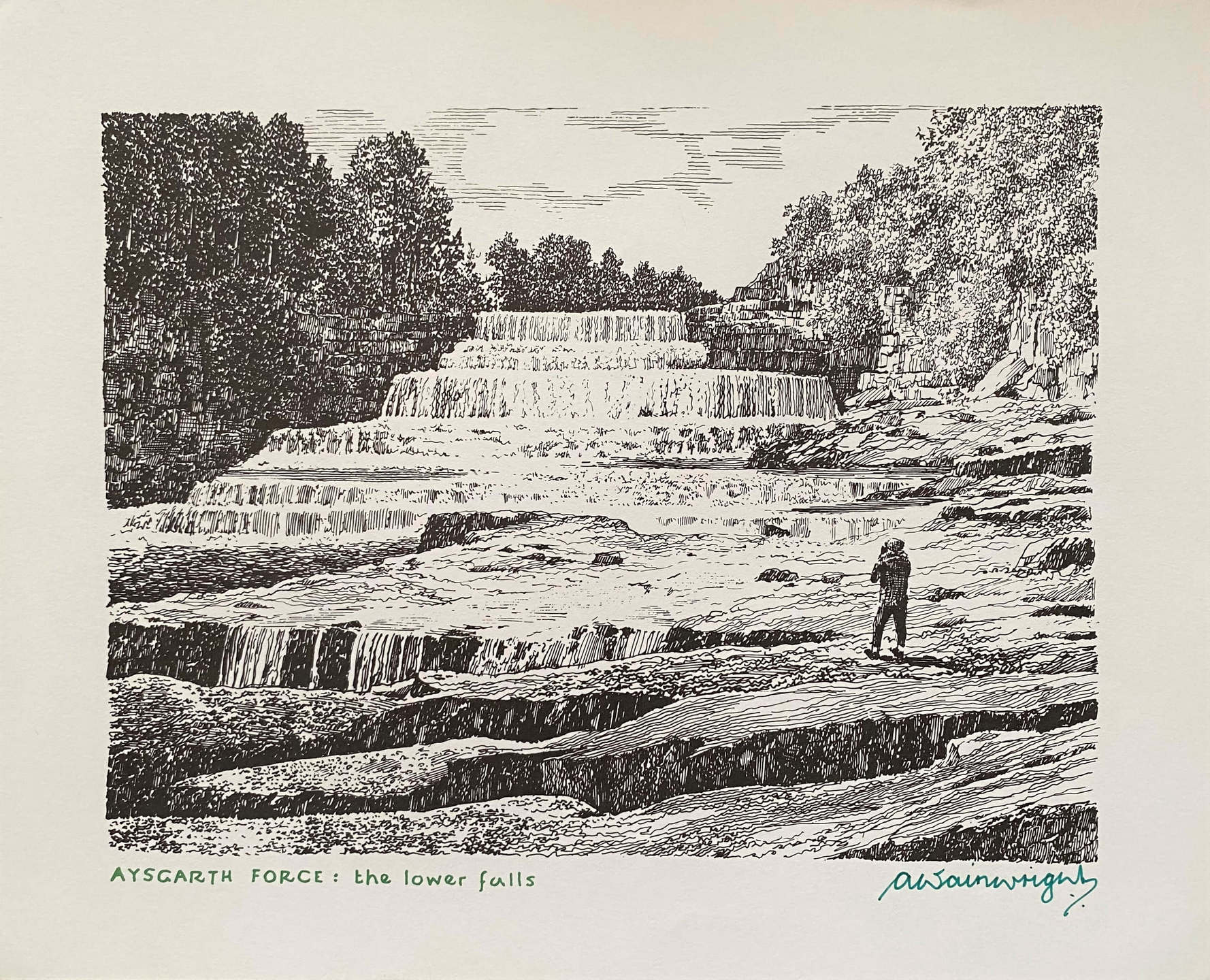
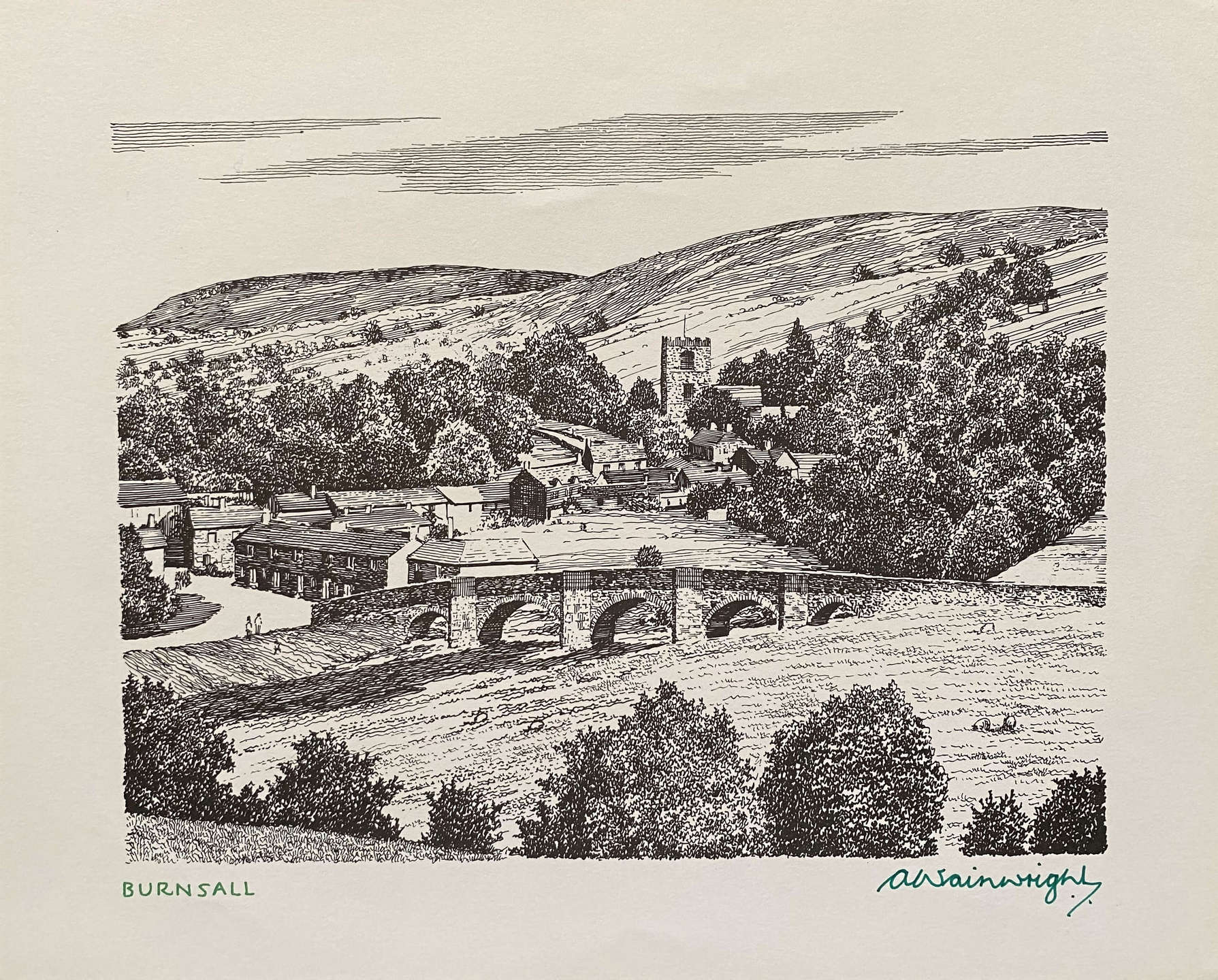
Kendal Collection (All prints from Kendal in the nineteenth century)
- KIRKLAND, KENDAL (10)
- HIGHGATE, KENDAL (30)
- HIGHGATE, KENDAL (33)
- THE TOWN HALL, KENDAL (35)
- YARD 83, HIGHGATE, KENDAL (39)
- OLD SHAMBLES, KENDAL (55)
- THE PUMP INN, KENDAL (61)
- STRAMONGATE, KENDAL (65)
- STRAMONGATE, KENDAL (66)
- YARD 89, STRAMONGATE, KENDAL (72)
- STRICKLANDGATE, KENDAL (87)
- STRICKLANDGATE, KENDAL (88)
- STRICKLANDGATE, KENDAL (89)
- STRICKLANDGATE, KENDAL (94)
- THE KING’S ARMS HOTEL, KENDAL (95)
- ENTRY LANE, KENDAL (104)
- THE COUNTY MEWS, KENDAL (111)
- FELLSIDE, KENDAL (115)
- THE SYKE, KENDAL (119)
- THE SYKE, KENDAL (120)
- FOUNTAIN BROW, KENDAL (129)
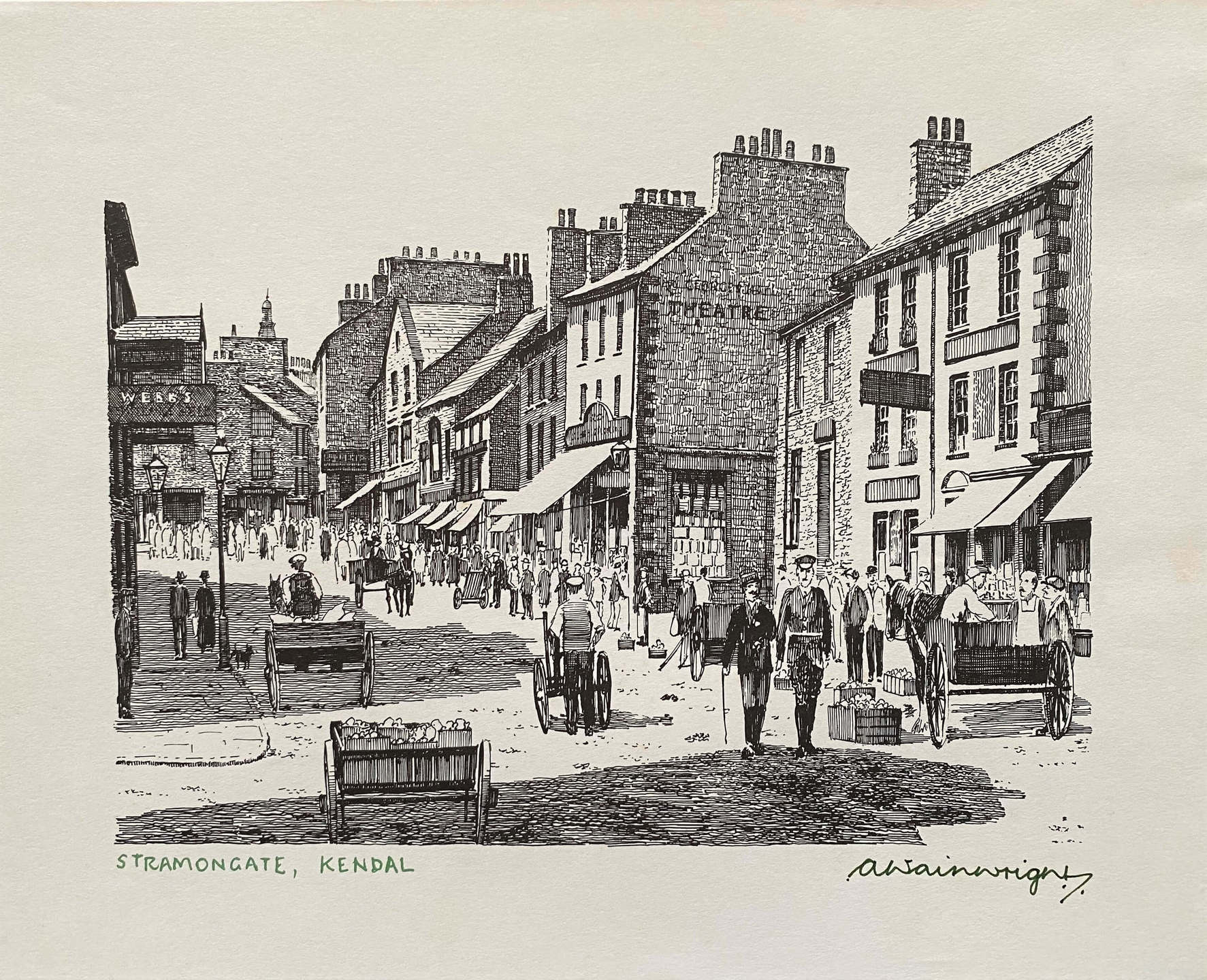
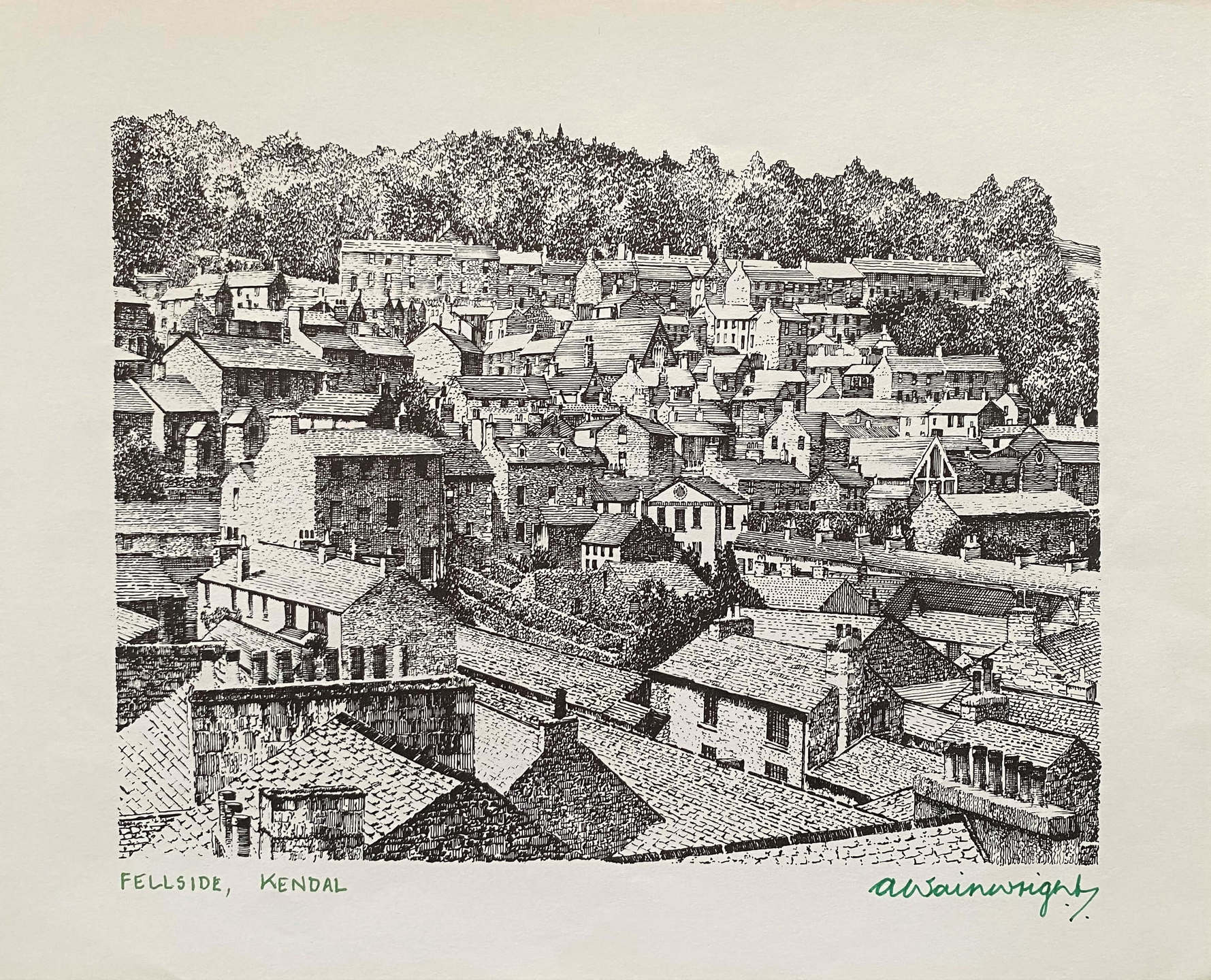
Ribble Collection (All prints from A Ribble Sketchbook)
- PEN Y GHENT, from Selside (5)
- THE RIBBLE AT STAINFORTH (9)
- MARKET PLACE, SETTLE (18)
- THE RIBBLE AT GISBURN (27)
- BOLTON BY BOWLAND (29)
- DOWNHAM (34)
- PENDLE HILL, from Downham (35)
- MEMORIAL GARDENS, WADDINGTON (39)
- CLITHEROE, from the Castle (43)
- EDISFORD BRIDGE (45)
- STONYHURST COLLEGE (48)
- THE CALDER VALLEY AT WHALLEY (55)
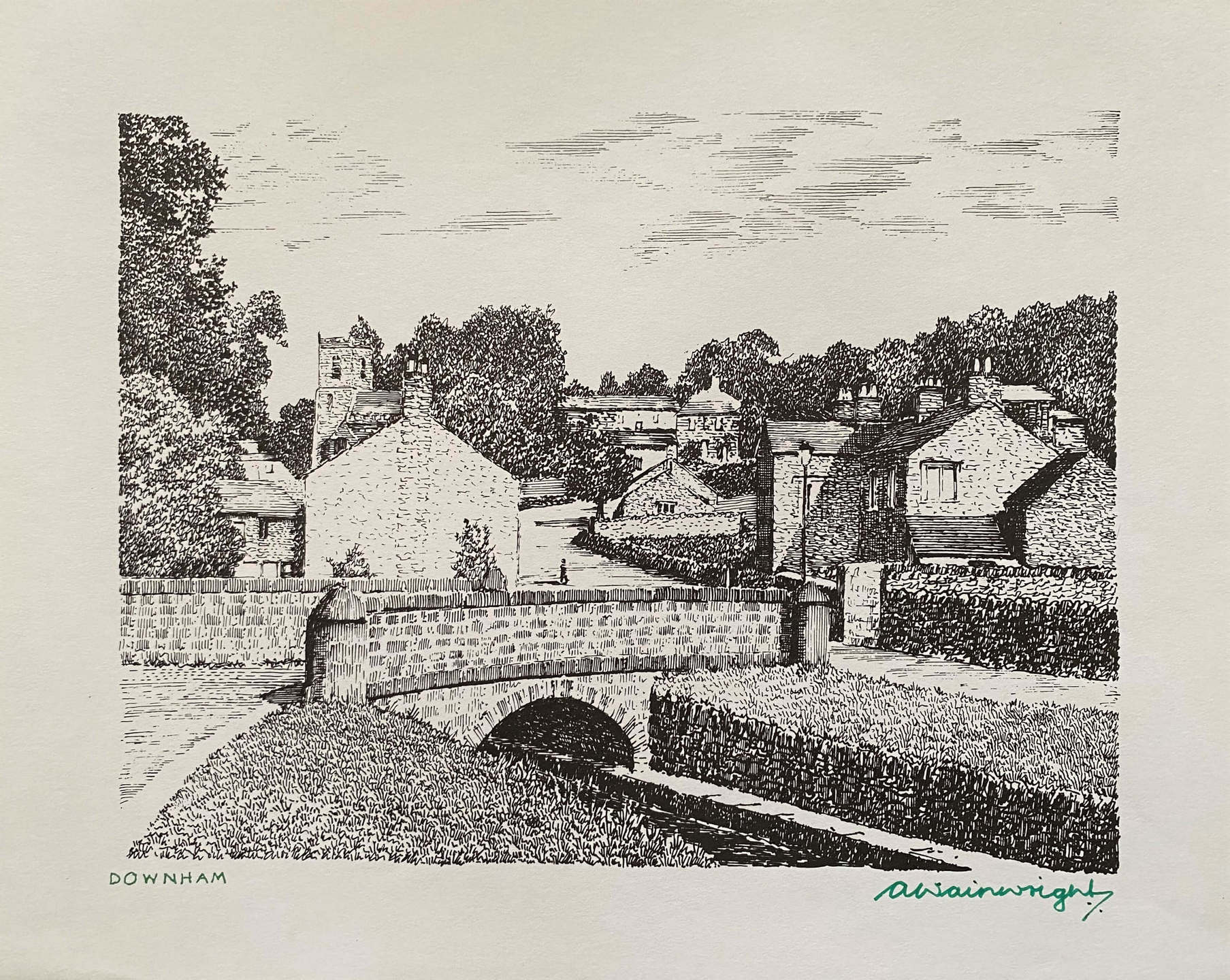
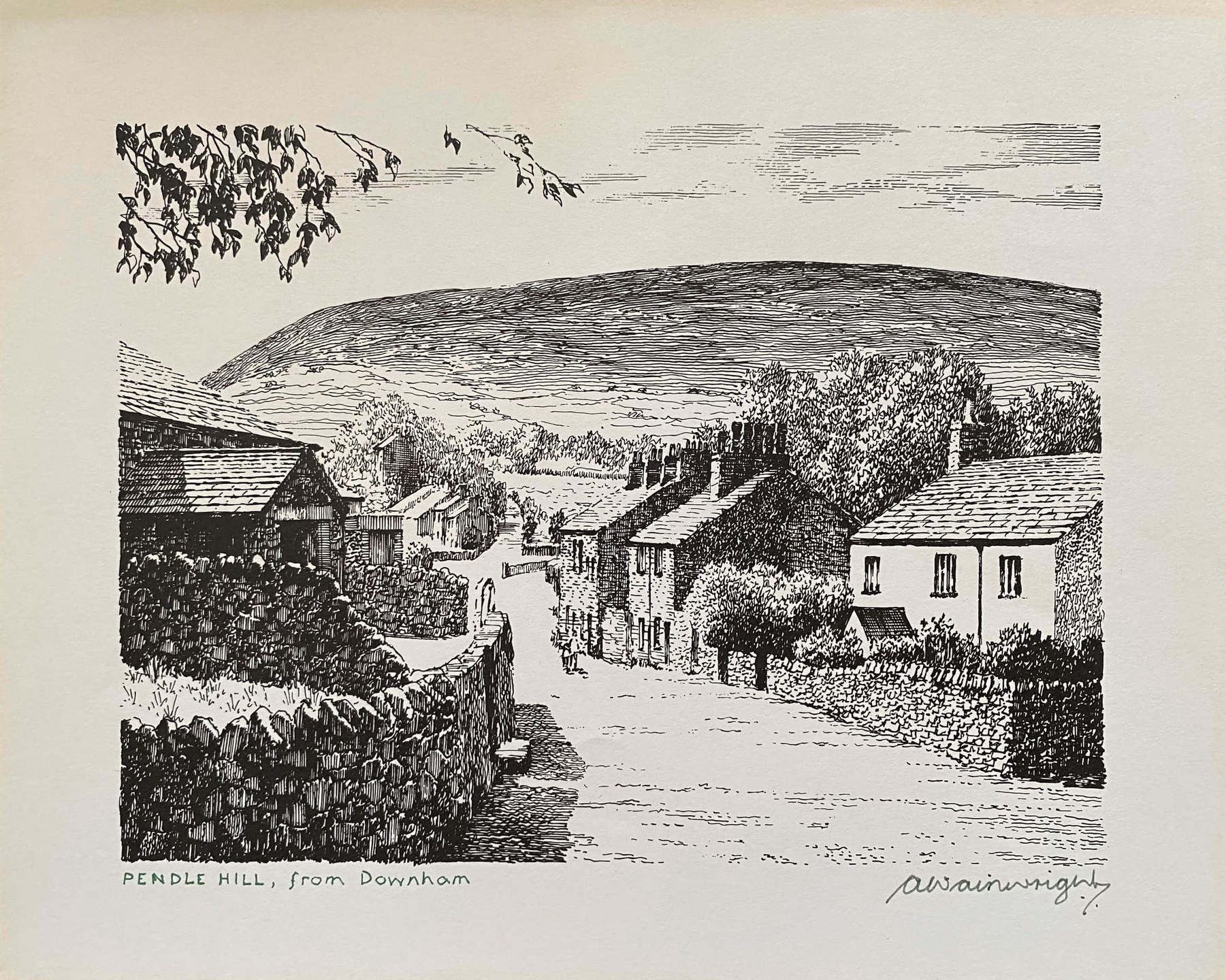
Uppercase lettering is used for the main part of the print titles, with lowercase for most suffixes. In the Sketchbooks, all titles are in lowercase except for the capitals on proper nouns. Some print titles were abbreviated from the sketchbook originals, and this was not always because of space limitations on the prints. For instance, Blencathra, from Castlerigg Stone Circle, was rather long and was reduced to BLENCATHRA, from Castlerigg. There seems to be less need to reduce The Patterdale Valley in the book to simply PATTERDALE on the print. There were a few other minor modifications – for instance, Penyghent, from Selside in A Ribble Sketchbook, became the spaced-out PEN Y GHENT from Selside. I could go on, but none of this amounts to a hill of beans, so I will stray no further into terra anorakia.
The format for each print was always the same. The location title in green lettering in the bottom left corner was produced as part of the printing process and so has been less vulnerable to fading than AW’s hand-written green signature in the bottom right. There is generally a characteristic dot on either side of the trailing final stroke of his signature. Some West Tanfield prints show a black signature – perhaps his regular green pen had run out of ink. These dark signatures are undoubtedly different from the ones with a sepia tinge caused by ageing or fading, particularly from direct sunlight damage. If the signature fading problem had been anticipated, greater care would probably have gone into AW’s choice of pens. But no one would have been thinking about the conservation of the prints in later decades. According to Andrew, the best seller was Langdale Pikes from Lingmoor Fell. The Lakeland series has always been the most popular, reflected in second-hand prices.
Conversely, some Dales prints have been available for as little as £20 or less, which is remarkable for such attractive items, each with a hand-drawn signature. The 21 prints in the Kendal series are a strange number and may have been due to an oversight. The Scottish Mountain Drawings were considered for a fifth series, but the idea was not pursued.
Some of you may have come across other signed prints, and here are the ones I know about. In 1985, Bob Swallow, an enterprising manager at the Lancaster branch of the Leeds Permanent Building Society, gave his mortgage customers a set of 4 Lakeland-signed prints. These were larger than the published prints and comprised: Ashness Bridge, Derwentwater from Castle Head, Scafell Pike from Throstle Garth and Langdale Pikes from Lingmoor Fell.
Occasionally, a signed print entitled Langdale Pikes from Chapel Stile comes up for sale. I once bought this print at an auction and can report many differences from the published prints – for instance, it is a different size, and the title is in lowercase. Moreover, would you want to publish a print with this title when you already had LANGDALE PIKES from Lingmoor Fell in the public portfolio? The back of my print said it had been donated by the artist to Cumbria County Scout Council “to help Council funds,” so I suspect a small print run was made for when AW received requests for help from local charities. Strangely, all the signatures on the prints I have seen are faded, so perhaps he signed them all in one batch using a pen with poor-quality ink.
Another one brought to my attention was Heron Corn Mill, Beetham. I know that postcards were made using AW’s illustration of the mill. I have seen a scan of what could have been a signed print. Alongside the signature was the date – 1978, which makes it different from the 73 published prints. If this were a hand-signed print rather than a pre-printed card, it would almost certainly have been done as another small batch with sales through local outlets. Once again, I feel this was probably AW helping a Cumbrian organisation in need by using his artistry to raise funds. A print of Sprinkling Tarn was once mentioned, and I would be very interested to hear from anyone who knows about this.
All of these additional prints differ significantly from the ones I have listed and, in my opinion, are not part of the four series published for the general public to buy.
There have also been printed cards showing Lakeland scenes taken from the sketchbooks. New collectors can easily be fooled into buying these on auction sites, thinking they are authentic hand-signed prints. AW’s signature is at the bottom right, but this was produced as part of the printing process. The location name is absent on some cards, and once again, the size is different from the published prints. Sometimes, the cards come up for sale in frames, adding to their plausibility. Attractive as they are, they are highly unlikely to have been hand-signed. If you have your eyes on a genuine signed print, check that the signature has not faded or the paper turned a light shade of brown because of direct exposure to the sun.
Following an earlier published article about my findings, I occasionally corresponded with people who have contacted me to say they have a print that I have missed from the list. After further investigation, it has been a great pleasure to tell them that their “print” is actually a very desirable original drawing. But if you have a signed print that has not been mentioned above or can add something to the story in other ways, it would be great to hear from you. This research remains a work in progress.
<<>>
Post Update – July 2024
When I wrote my guest article about “The Wainwright Prints”, I began by saying that although I had learnt a lot about the prints over the years, this remained an ongoing pursuit. This has indeed proved to be the case! My eyes opened wide when I recently saw a Wainwright print of Casterton School come up for auction. I made a successful bid and now have this item in my collection.
The print is drawing 46 in AW’s A Lune Sketchbook (1980). The print has a signature but no location title. The signature is in black and may have been reproduced as part of the printing process. The illustration itself is the same size as in the book, but the card on which it appears measures an impressive 14 by 11 inches. The published prints are on paper that measures just 10 by 8 inches. I have never seen this print come up for sale before or spotted any mention of its existence. This is clearly not one of the published prints. So what could it be?

My first port of call was the school itself to see if they could throw any light on things. The school archivist informed me that Casterton School merged with Sedbergh School in 2013. She said the print was “reproduced fairly widely”, and the School had a few copies. But there were no answers as to when or why it was created or how many. A few ideas have occurred to me. For instance, the school moved to its Casterton site in 1833. So, in 1983, it would have been there for 150 years. Could the print have been produced to celebrate this milestone anniversary? The book from which it was taken was published in 1980 so that would fit in well.
Alternatively, could it have been produced as part of some fundraising initiative, as I think was the case for Wainwright’s print of Heron Corn Mill in 1978? There was also “Langdale Pikes from Chapel Style,” which may also have been one of AW’s charitable donations. The four prints that the enterprising manager, Bob Swallow, of the Leeds Permanent Building Society, produced for his customers were certainly larger than the regular published prints, but there are many differences to the mystery one.
So, if anyone has any further information about the Casterton School prints, I would be delighted to hear from you.
<<>>
Graham Wilkinson
wilkinson20@btinternet.com
Wainwright photo courtesy of The Margaret Duff Collection
Back to top of page

